
In today’s world, staying connected is essential, even for those embracing the freedom of off-grid living. Thanks to modern technology, digital connectivity is possible even in remote locations, allowing off-grid nomads to maintain access to online services, work, and communication. Whether for remote work, staying in touch with loved ones, or accessing emergency services, staying connected while living off-grid is more feasible than ever.
The Evolution of Off-Grid Living
At its core, off-grid living is about independence—living outside the reach of traditional utilities like electricity, water, and sewage systems. For many, this lifestyle represents freedom from modern constraints, offering a closer connection to nature and a smaller environmental footprint. While the focus is often on generating power, sourcing water, and sustainable living, digital connectivity has become a vital aspect of off-grid life.
Whether you’re embarking on an off-grid adventure in a tiny house, RV, or remote cabin, maintaining digital connectivity helps you bridge the gap between self-sufficiency and the modern world. Let’s explore the tools and techniques that make this possible.
The Need for Digital Connectivity in Off-Grid Life
In our increasingly digital world, being disconnected for long periods isn’t always practical. Whether you’re working remotely, attending online classes, or simply wanting to stay informed, maintaining digital connectivity while off-grid is essential. For nomads traveling to remote areas, staying online enables them to manage personal and professional commitments while enjoying the freedom of off-grid living.
Off-Grid-Friendly Technologies for Digital Connectivity
To ensure uninterrupted digital connectivity while living off-grid, a combination of innovative technologies and sustainable energy solutions is essential. Here are some practical tools to keep you connected:
1. Off-Grid Internet Solutions
Off-grid internet solutions have advanced considerably, making it easier than ever to stay online. Satellite internet services like Starlink offer high-speed connections even in remote areas. With constellations of low-Earth orbit satellites, these systems provide a reliable internet connection where traditional cellular or wired options are unavailable.
In addition to satellite services, mobile hotspots powered by cellular networks can also keep you connected. When traveling through regions with adequate cellular coverage, mobile hotspots are an effective solution for digital connectivity.
2. Renewable Energy-Powered Connectivity
For off-grid nomads, sustainable power is critical to maintaining digital connectivity. Solar panels, wind turbines, and portable power stations ensure you have a reliable source of electricity to charge devices, power internet routers, and keep communication tools online.
- Solar Panels: Solar energy is one of the most popular choices for off-grid power. Solar panels can be mounted on RVs, tiny homes, or portable setups to collect energy and store it in batteries.
- Wind Turbines: In windy areas, wind turbines can supplement solar power by generating electricity during overcast days or at night.
- Portable Power Stations: These units store energy from solar panels or wind turbines, providing power for devices and internet equipment when needed.
3. Off-Grid Communication Tools
Traditional communication methods may not be reliable in off-grid areas, so it’s essential to have alternatives. Satellite phones, radios, and mesh network devices provide reliable communication without depending on cellular towers. These tools are particularly useful for staying connected in emergencies, ensuring that off-grid nomads have access to help when needed.
- Satellite Phones: Provide reliable, long-range communication in remote areas where cellular networks fail.
- Mesh Networks: These devices create local networks that allow communication between nearby devices without requiring an internet connection.
4. Digital Nomad Solutions
Nomadic living, particularly in RVs or tiny homes, requires flexible solutions for digital connectivity. Mobile hotspots, cellular routers, and RV-friendly internet systems are tailored for individuals on the move, ensuring that you can work or connect to the internet from virtually anywhere.
- Mobile Hotspots: Cellular-based hotspots are perfect for nomads traveling in areas with strong mobile network coverage. These devices provide internet access on the go.
- RV Internet Systems: Specialized systems designed for mobile homes or RVs ensure stable connectivity while traveling between remote locations.
5. Smart Off-Grid Homes
Smart home technologies can be integrated into off-grid living to enhance digital connectivity. By using mobile apps to monitor energy usage, control appliances, and optimize resource management, off-grid residents can improve efficiency while staying connected.
Smart devices can monitor energy levels in solar panels, adjust lighting, or control heating and cooling systems—all from a mobile device. This allows off-grid residents to manage their homes efficiently, even while traveling or in remote locations.
Maximizing Digital Connectivity Off-Grid
To get the most out of digital connectivity while living off-grid, it’s important to plan ahead and optimize your setup. Here are a few tips to stay connected efficiently:
- Choose Reliable Internet Options: Depending on your location, choose the most reliable internet option, whether satellite, mobile hotspots, or mesh networks.
- Optimize Energy Usage: Use renewable energy sources like solar and wind to power your internet setup sustainably. Invest in energy-efficient routers and devices to minimize power consumption.
- Back Up Power: Always have a backup power source, like a portable power station or additional solar panels, to ensure you stay online even during bad weather or outages.
- Stay Prepared for Emergencies: In remote areas, have satellite communication tools ready to stay in touch, especially when traditional methods fail.
Conclusion: Staying Connected in the Off-Grid World
Thanks to advancements in technology, digital connectivity is no longer a luxury for off-grid living but a necessity. By embracing off-grid internet solutions, renewable energy, and alternative communication tools, off-grid nomads can maintain their independence without sacrificing the ability to stay connected. Whether for work, personal communication, or safety, these tools ensure that even in the most remote locations, the digital world is only a click away.
